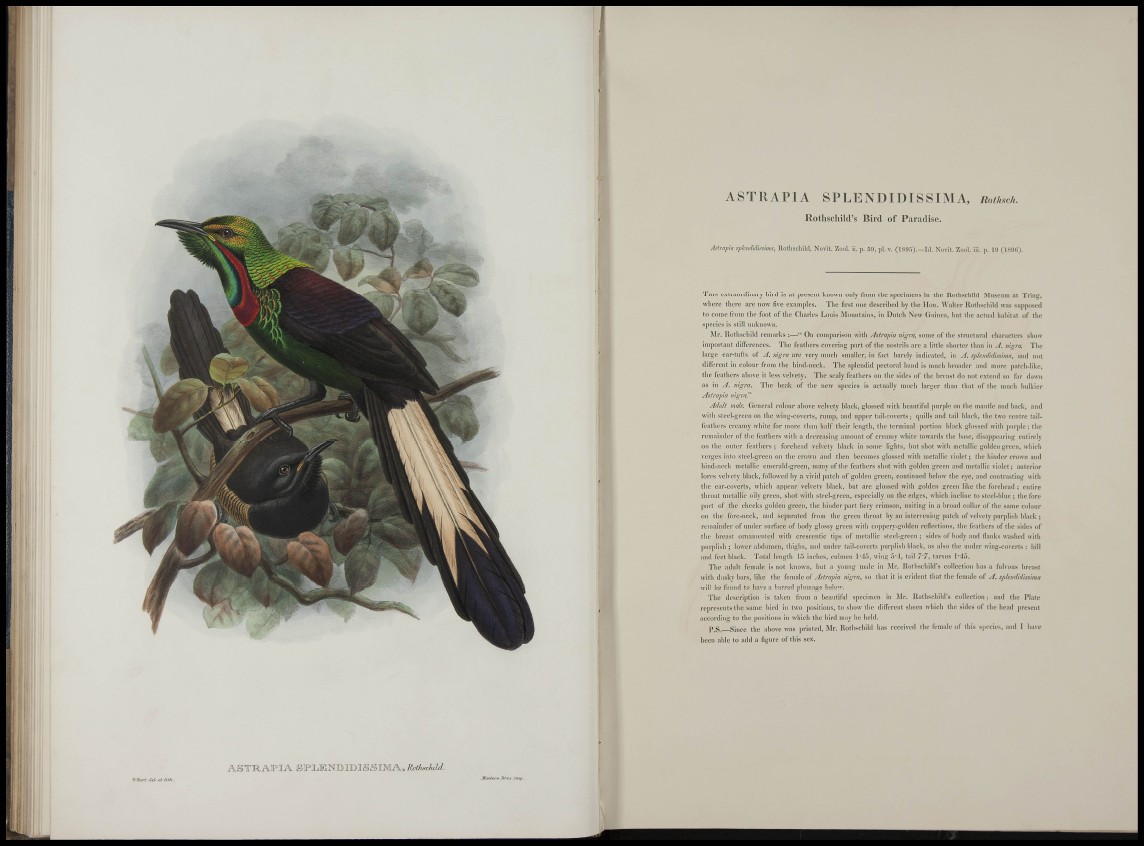
I r
'"il.
ä •
!
li
Ì
ASTRAPIA SPLENDIDISSIMA, RoM.
Rothschild's Bird of Paradise.
Astrapia splendidisshm, Rothschild, Novit. Zooi. ii. p. 59, pi. T. (1895).—H. Novit. Zool. iii. p. 1!) (189IÌ).
THIS extraordinary bird is at present known only from tlic specimens in tlie Uotliseliild Mnseuin at Tring,
wliere tliere arc now five e.vampies. The first one described by the Hon. Walter Rotliseliild was siii>pose(l
to come from the foot of the Charles Louis Mountains, in Dutch New Guinea, Init the actual habitat of the
species is still unknown.
Mr. Rothsehild remarks :—" On comparison witli Astrapia nigra, some of the structural characters show
important differences. The feathers covering part of the Tiostrils are a little shorter than in A. nigra. The
large ear-tufts of A. nigra are very ninch smaller, in fact barely indicated, in A. spkndidiuima, and not
different in colour from the hiud-necli. The splendid pectoral band is much broader and niore patch-like,
the feathers above it less velvety. The scaly feathers on the sides of the breast do not c.Mteiid so far down
as in A. nigra. The beak of the new species is actually much larger than that of the niuch bulkier
Astrapia nigra."
Adult male. General colour above velvety black, glossed with beautiful purple on the mantle and back, and
v^•itil steel-green on the wing-coverts, rump, and ujijx'r tail-coverts; quills and tail black, the two centre tailfcatliers
creamy white for more than half their length, the terminal portion black glossed with jnirple; the
remainder of the feathers with a decreasing amount of creamy white towai-ds the base, disajjpearing entirely
on the otiter feathers; forehead velvety black in some lights, but shot with metallic golden green, which
verges into steel-green on the crown and then becomes glossed with metallic violet; the hinder crown and
hitid-ncck metallic emerald-green, many of the feathers shot with golden green and metallic violet; anterior
lores velvety black, followed by a vivid jiatch of golden green, continued below the eye, and contrasting wilh
the car-coverts, which appear velvety black, but are glossed with golden green like the forehead ; entire
tliroat metallic oily green, shot with steel-green, especially on the edges, which incline to steel-blue ; the fore
¡lart of the cheeks golden green, the hinder part fiery crimson, ntiiting iii a broad collar of the same colour
on the fore-neck, and separated from the green throat by an intervening patch of velvety purjilish black ;
remainder of under surface of body glossy green with coppery-golden i-efiections, the feathers of the siiles of
the breast ornamented witb crescentic ti|)s of metallic steel-green ; sides of body and flanks washed with
pur])lish ; lower abdomen, thighs, and under tail-coverts ])urplisli black, as also the under wing-coverts : bill
and feet black. Total length 15 inches, cuhnen ^•4o, wing 5'4, tail 77, tarsus 1-45.
The adidt female is not known, but a young male in Mr. Kothschild's collection has a fulvous breast
with dusky bars, like the female oi Astrapia nigra, so that it is evident that the female of A. spkndidissima
will be found to have a barred |)lumage below.
The description is taken from a beautiful specimen in Mr. Rothschild's collection; and the Plate
represents the same bird in two positions, to show the different sheen ivhich the sides of the head ¡¡resent
according to the positions in which the bird may be held.
P.S.—Since the above was printed, Mr. Rothschild has received the female of this species, and I have
been able to add a figure of this sex.
A S T M A P I A S]PJL]ENDIDISSIMA,/?i'M.5cAAZ,
iVaw^ deL .ftU/h. JtLniPj'n BJ-CS imfi.